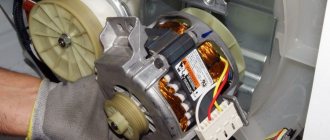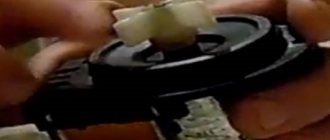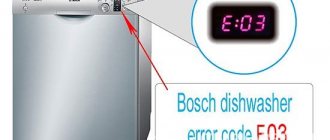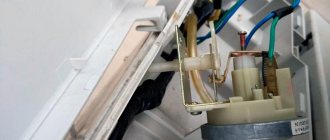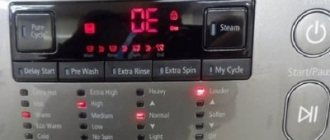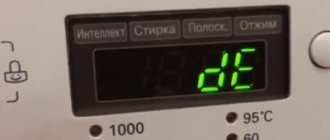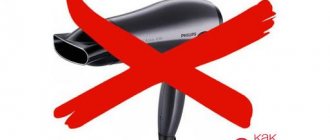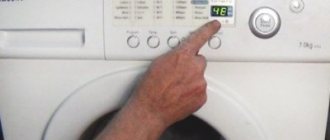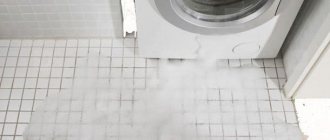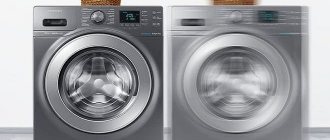If during washing the washing machine takes in water and then immediately drains it, it is impossible not to notice it. The cycle lengthens noticeably, the noise of liquid being flushed down the drain is constantly heard, and things remain dirty.
This can be caused by a variety of reasons, but the most common are:
- when connecting the device to the sewer, the water drain hose was installed incorrectly;
- blockage in the sewer system;
- malfunction of the dirty fluid drain valve;
- damage to the pressure switch;
- The electronic module has failed.
It is recommended to start fixing the problem immediately - a breakdown of this kind can lead to severe wear and tear on the internal elements of the machine or flooding of the apartment.
Incorrect sewer connection
The most common problem that arises after installing new equipment or when moving old equipment to another location.
To check if the hose position is incorrect, you can use two methods:
- Visual inspection. The hose must be fixed above the level at which the washing machine tank is located (approximately half a meter from the floor level or slightly higher). This position eliminates the situation of spontaneous leakage of liquid from the tank. Otherwise, the collected water will be drained, the level sensor will react to a decrease in the water level and send a signal to add new water. The cycle will repeat.
- If you cannot get to the hose, then use the second method to check its correct position. Start the wash cycle and wait to see if the machine starts draining water. If the answer is yes, then the cause of the failure has been identified. Dealing with it on your own is quite simple - you should change the position of the hose in accordance with the standards.
Usually, the machine comes with a special plastic loop that needs to be attached to the back wall of the device and the hose passed through it.
Software module malfunction
This kind of breakdown is also common. It is quite easy to determine it, just take a closer look at the operation of the machine. You need to turn on the machine in each mode in turn. If the washing machine constantly drains water in only one of the modes, but works normally in the others, then this is a malfunction of the microcontroller. In this case, the entire module needs to be replaced.
There are craftsmen who can restore the operation of the module simply by reflashing it. You can do this yourself, since there are many instructions on this topic. Then you will have to purchase a programmer and install special programs on your computer, which is also not very profitable. It is best to seek help from a specialist or service center.
Breakdown of the pressure switch
If the device previously worked properly, but now it collects and immediately drains water, then the breakdown may be caused by a failed part.
The pressure switch is responsible for controlling the water level in the tank. When the container is filled to the required level, the sensor gives a signal and the collection of water into the unit is completed.
The pressure switch fails if:
- contacts have oxidized;
- contacts close;
- the membrane is depressurized;
- the pressure pipe is clogged or damaged.
Incorrect operation of the pressure switch can lead to the tank overflowing and water from the machine to leak into the apartment and onto the lower floors.
Solution
Before carrying out any repair work, be sure to disconnect the device from the network.
The water level sensor is located on the rear of the machine. To get it yourself, remove the cover of the device and find the pressure switch. Remove the fasteners, inspect the condition of the part to see if there are any traces of oxidation on the contacts. If they are oxidized, they need to be cleaned.
A sensor tube covered in cracks is a reason to completely replace the unit. Its cost is low, and the process itself is simple.
Procedure for replacing the sensor:
- Disconnect the thin hose going to the compression chamber from the sensor.
- Disconnect the terminals, unscrew the 2 screws securing the pressure switch, and remove it.
- Secure the new one in its place and screw in the screws.
- Connect the terminals.
- Reconnect the thin hose.
- Replace the washing machine cover.
Before assembling the lid, you can carefully, observing safety precautions, start the machine to work without laundry in the drum. If the washing goes well, then the problem is resolved and the case can be assembled. Remember to unplug the device again before starting work. But if the device is still faulty and immediately drains water as soon as it fills, then the reason is different.
Clogged sewer pipe
This effect can occur if you live on the lower floors of a multi-story building. Residents living on the floors above throw whatever they find down the drain, thereby clogging the drain pipe. Then a vacuum is created at the bottom of the clog, which forcefully sucks water out of the washing machine. The Indesit washing machine especially suffers from this problem, constantly draining water and adding it back.
To avoid this effect and this problem, you need to disconnect the drain hose from the sewer and try to secure its end to the sink or toilet. Then air will penetrate into the system along with water and there will be no vacuum in the sewer. If the hose is short and does not reach the sink or toilet, then you can simply throw it into a bucket or tank, which, when filled, is poured into the same sink.
Drain valve failure
If the drain valve is not working, the washing machine constantly draws water into the tank. This problem can be resolved by completely replacing the component.
Before starting work, the machine is disconnected from the network. For a device with vertical loading, remove the side panel (the valve is located at the bottom); for a horizontal device, remove the top cover; the required element is located immediately below it. It is necessary to select a valve that is completely identical to the one removed. When purchasing it, also purchase the clamps that will be needed to secure the wires and hoses.
Replacement procedure:
- Find the valve and carefully disconnect the hoses and wires from it.
- Unscrew the screws or bend the latches, depending on the type of valve fixation.
- Turn the part and remove it.
- Install the new valve, secure it, attach hoses and wires, secure them with clamps.
- Replace the panel.
What can you do before calling a specialist?
There are several manipulations that you can and should do yourself before a specialist arrives. Let's consider the most necessary actions, according to the expected problems.
Check the water pressure from the tap
There are two main ways to find out the exact pressure in the water supply network: with a pressure gauge and with the help of mathematical calculations. The first method is simpler, but requires the purchase of a device. The second method requires a two-meter hose and calculations using a special formula. But the easiest way is to simply open the tap and visually assess the water pressure.
Clear a blockage in the sewer
A combination of baking soda with boiling water, vinegar or salt will help get rid of a common plumbing problem. Mechanical cleaning involves using a plunger or a small cable. The hydrodynamic method will require special pumps and machines.
Check that the washing machine is connected correctly
Models that do not have a special check valve are installed taking into account the level limitation. This determines the location of the outlet hose. The manufacturer indicates in the instructions the parameters for the maximum and minimum values of this level.
An additional siphon is purchased before connecting the washing machine drain. It is necessary to connect the sewer and drainage systems. The hose and water drain from the sink must be securely fastened. Then there will be no leaks.
After connecting, check the pipe for kinks. It is fixed at a height of 80 cm from the floor, along the back wall of the machine. The drain hoses are connected by adapters with clamps.
Clean the drum
It is easy to remove mineral deposits from the surface of the drum using available tools. Vinegar or citric acid will help. After washing-self-cleaning, you should wash the surface of the sealing rubber with a sponge.
Check the integrity of the hose and connections
Since a leak may be due to damage to the outlet hose, it is necessary to assess the integrity of the pipe itself and the connections to the sewerage system and the machine body.
Clean the filter
The filter is located at the bottom of the washing machine behind a special lid. First, you need to place a rag under it, then unscrew the filter itself. Then water will begin to flow out, which can be easily removed with a rag. Clean the surface of the filter with a sponge and rinse in the sink.
Electronic module failure
Problems with water intake and drainage may be caused by a malfunction of the electronic module. In this case, the display, if available, displays an error code to help you figure out what the reason is. Try rebooting the device completely and starting it again. If after this the washing machine again drains water immediately after filling, it is recommended to call a specialist. In this case, it will be quite difficult to independently identify and eliminate the problem.
Any breakdown requires prompt repair. If you continue to try to operate the washing machine when it is draining water, you can permanently damage the equipment.
Broken software module
A software module is a complex electronic device. It includes a microcontroller that controls the washing machine modes. The microcontroller can fail either completely or partially if high voltage is applied to it. If it burns out, the machine will simply stop working. If it fails partially, then this is fraught with malfunctions in the operation of the machine. Know that if the Zanussi washing machine constantly drains water in all modes, then this may be one of the reasons. In this case, the module must be replaced.
Oxidation of sensor contacts
If the washing machine constantly drains water, the reason may also be oxidation of the sensor contacts. Naturally, a washing machine is a source of high humidity. And the terminals at the ends of the wires that connect to the sensors are made of copper or aluminum. Moisture entering these terminals leads to oxidation of the metal. As a result, contact is lost at the connection points. Weak contact leads to malfunction of the machine, and may be one of the reasons why the washing machine constantly drains water. The cure is simple: you need to remove the terminal blocks from all sensors, the pump, the software module, and simply clean them with emery cloth or a needle file. Having put everything back together, you can enjoy the good performance of the machine.
Possible violations of operating rules
Sometimes the reason for washing without spinning can be caused by simple inattention.
Wrong washing program selected
In this situation, the spin cycle does not work in the appliance. But rushing to wring out wet things with your hands is not an option. It is better to read the instructions more carefully. Not every washing program requires a spin cycle. Sometimes the laundry is spun at low drum speeds, or the wash cycle ends with a rinse. Then the water drains from the car, but the things inside remain wet. If, after opening the hatch door, the presence of water in the tank is detected, you need to check how the program options are set. Perhaps spinning is not intended initially. For example, if a gentle mode is selected for items made from delicate types of fabrics, and so on. The problem is not such, since everything will be fixed by resetting the regulator to the desired function.
But it also happens that the spin cycle is simply accidentally turned off by one of the household members. To spin out the washed items in this case, you just need to reset the regulator to the “Spin” option and start the process using the “Start” button. The number of revolutions on the regulator is not set - also one of the banal reasons for the spin failure. At the zero mark, the machine does not provide for spinning the laundry. The water will simply drain out and the cycle will end.
Uneven distribution of laundry
This is what upsets the balance of the washing machine. Models with a display report a balancing problem with the information code UE or E4. In other devices, the washing process simply stops at the spin stage, and all indicators light up simultaneously. Often, when there is an imbalance, the laundry in the drum gets bunched up. Incorrect loading of bedding also causes a program failure. For example, when they were stacked in a tank. To eliminate the imbalance, it is enough to manually distribute the laundry evenly.
Drum overload
Eliminating weight overload is the easiest thing to do. You just have to remove some of the laundry from the washing machine. Or try to redistribute things and restart the “Spin” function. Exceeding the maximum permitted weight poses a danger to the device, therefore, in case of such a violation, an error code is displayed on the display or the entire process stops. The situation can be easily resolved by turning off the power and removing some of the items from the washing tank. To prevent the drum from overloading in the future, you need to load laundry according to the operating instructions
It is important to take into account the fact that wet clothes become heavier, so maximum load is undesirable
Imbalance and overload are equally unsafe for washing machines. The automation stops operation before the start of the most active phase of washing - spinning at high speeds.
